EURECA
Good Practices



 Pictures:
Pictures:Generic desalination plant created by IA
Valencia Desalination Plant: Nurturing Urban Ecology Through Sustainable Water Solutions
Country:Main Subject:
Description:
The desalination facility in Valencia stands out as a prime model of technology integration with environmental consciousness. Situated in a coastal city prone to periodic water shortages, Valencia has adopted innovative strategies to ensure a sustainable water supply.
Strategically positioned along the coastline, the Valencia Desalination Plant taps into seawater as its primary source, alleviating strain on inland freshwater resources and catering to urban water demands. Utilizing energy-efficient desalination methods like reverse osmosis, the plant transforms seawater into potable water, aligning with urban ecological principles by curbing the carbon footprint associated with water treatment.
Several desalination plants across Spain, including those in Valencia, have embraced renewable energy sources like solar and wind power, furthering urban ecology objectives by advocating for sustainable practices and reducing reliance on non-renewable energy.
Efficient brine management practices are imperative to mitigate adverse effects on marine ecosystems. The Valencia Desalination Plant employs advanced brine disposal techniques to responsibly handle concentrated brine waste, minimizing ecological disruptions along the coastal zone.
The desalinated water from the facility seamlessly integrates into the city's water distribution network, offering a supplementary and sustainable freshwater source. This integration not only meets urban water demands but also eases the strain on conventional freshwater reservoirs.
Continual research and monitoring efforts play a vital role in the plant's operations. Environmental impact assessments and ecosystem studies contribute to refining desalination methods, and prioritizing ecological preservation.
Emphasizing community involvement, the Valencia project prioritizes public awareness and engagement. Educating residents about desalination's benefits and challenges fosters a sense of environmental responsibility, aligning with urban ecology principles.
Overall, the Valencia Desalination Plant sets a commendable example of implementing desalination technology to address urban water needs while upholding environmental considerations in a coastal urban setting.
Reference links:
https://www.acuamed.es/media/publicaciones/Acuamed_Folleto_IDA13.pdf
https://www.acuamed.es/en/action/desalination-plant-sagunto-valencia
https://www.imida.es/documents/13436/877249/06_REPORT_ON_WATER+DESALINATION.pdf/ae6203f4-68f9-4a37-b728-22b5d247909e
https://www.belvessels.com/sites/default/files/projects/case-study_2.pdf
https://www.setapht.com/proyectos/planta-desalinizadora-de-sagunto-valencia/
SDG direct/ indirect short justification:
DIRECT SDGs:
- Clear water and sanitation: Ensure Availability and sustainable management of water and sanitation for all (SDG 6)
- Industry, innovation and infrastructure (SDG 9)
- Sustainable cities and communities (SDG 11)
INDIRECT SDGs:
- Life on land (SDG 15)
- Good Health and Well Being (SDG 3)
- Responsible Consumption and Production (SDG 12)
- Climate Action (SDG 13)
- Life below water (SDG 14)
Justification:
- Clear water and sanitation (SDG 6): Valencia Desalination Plant best practice directly contributes to SDG 6 by providing a sustainable source of clean water, particularly in coastal urban areas facing water scarcity, directly supporting the goal of ensuring availability and sustainable management of water.
- Industry, innovation, and infrastructure (SDG 9): Valencia Desalination Plant demonstrates innovation in desalination technology and sustainable infrastructure development, aligning with SDG 9 while it encourages innovation in water-saving technologies, contributing to sustainable industry practices.
- Sustainable cities and communities (SDG 11): Valencia Desalination Plant example directly contributes to creating sustainable urban water solutions, fostering resilience in the face of water scarcity. It promotes sustainable water use in urban and industrial settings, supporting the development of sustainable communities.
- Life on land (SDG 15): Valencia Desalination Plant minimizes the impact on terrestrial ecosystems by relying on seawater for desalination, indirectly contributing to SDG 15. By reducing pressure on freshwater sources, indirectly supports the preservation of land ecosystems.
- Good Health and Well Being (SDG 3): Valencia Desalination Plant ensures a sustainable supply of clean water, directly contributing to improved health and well-being, aligning with SDG 3.
- Responsible Consumption and Production (SDG 12):This best practice example encourages responsible water consumption practices, aligning with SDG 12's focus on sustainable consumption.
- Climate Action (SDG 13): Valencia Desalination Plant addresses water scarcity challenges exacerbated by climate change, contributing indirectly to SDG 13.
- Life below water (SDG 14): Valencia Desalination Plant minimizes the impact of desalination on marine ecosystems through responsible brine management, indirectly contributing to SDG 14.
Keywords:
City:
Questions:
- What desalination technology does the Valencia Desalination Plant employ, and how does it support urban ecology?
- How does the plant prioritize energy efficiency in its desalination procedures, and what significance does this hold for urban ecology?
- How do certain desalination facilities in Spain, such as the one in Valencia, promote urban ecology by incorporating renewable energy sources?
- Why is effective brine management critical for desalination facilities, and how does the Valencia Desalination Plant tackle this challenge?
- In what manner does the desalinated water generated by the Valencia Plant contribute to the urban water distribution system, and what advantages does this integration provide?
Authors:
Internet Web Solutions




